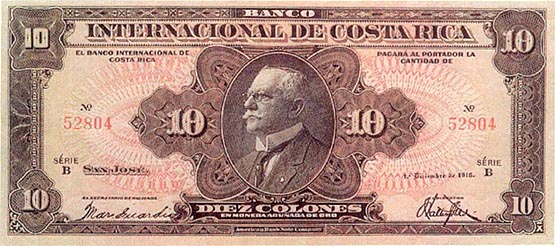| Obverse Design | The token has an inner circle. Inside the circle is a large "10" with the word "CENTS" under it, Outside the circle, the legend "FIELD BRODIE & CO" curves along the top of the token, with a dot under the "O". The legend "1885" curves along the bottom with a dot divider on either side. The token has a dentured edge, and a raised rim. | ||||
| Reverse Design | The token has an inner circle. Inside the circle is a large "10" with the word "CENTS" under it, and a small "B" (the mintmark) under that. Outside the circle, the legend "SAVINGS BANK OF COLON" curves along the top of the token. There is a large dot divider at the bottom where the legend begins and ends. The token has a dentured edge, and a raised rim. | ||||
| Metal | Silver, possibly .667 fine which was the Columbian standard at the time. | Size and Shape | Round, 20 mm in diameter. Reeded edge. | ||
| Dates Issued | 1885. | ||||
| Issurer | Field Brodie & Co. Savings Bank of Colon. | ||||
| Mintage | Unknown. | ||||
| Rarity | Rare. | Manufacturer | Mint mark is "B", but which mint this represents is unknown. Rulau tentatively attributes it to Bogota, but mint officials have denied producing this token. | Source | Asociación Numismático's F-263, Eklund #1069, Henkle's Colon #19 (photo), Plumer page #3, Rulau's Col-60. |
| Varieties | None known. | ||||
| Function | Merchant token. | ||||
| Population Count |
Known specimens are as follows:
|
||||
| Notes |
Field, Brodie and Company was formed January 1, 1885 per an advertisement in the Star & Herald newspaper. Field was Walter Joseph Field whose father was running the Exchange Bank of Colon (which issued some rare notes). Brodie's full name is unknown, but most likely he was a relation of Walter Field since Walter's father's fourth wife was a Brodie. The year 1885 was a bad one for Colon. In late March, a group of insurgents under Pedro Prestan took possession of the city and extorted forced loans from the merchants. On March 30th, during a battle with Columbian troops, the insurgents set fire to the city and burnt most of it to the ground. Prestan fled but was later caught and hanged on Front Street in Colon on August 18th. Sometime in 1885, date unknown but most likely after the city burned down, both the Savings Bank of Colon and the Exchange Bank of Colon closed up shop. An advertisement in an 1885 Star & Herald solicited account holders of the Exchange Bank to present themselves for liquidation. Walter J. Field moved to Costa Rica where he lived for 40 years. He was President of Banco Internacional de Costa Rica for some years including 1917 when his picture appeared on the 10 Colon note issued by that bank. Around 1925 Walter J. Field moved to California. Walter's father died in 1892 and was buried in England.
|
||||

Courtesy of Rhonda J. Field Goldfuss